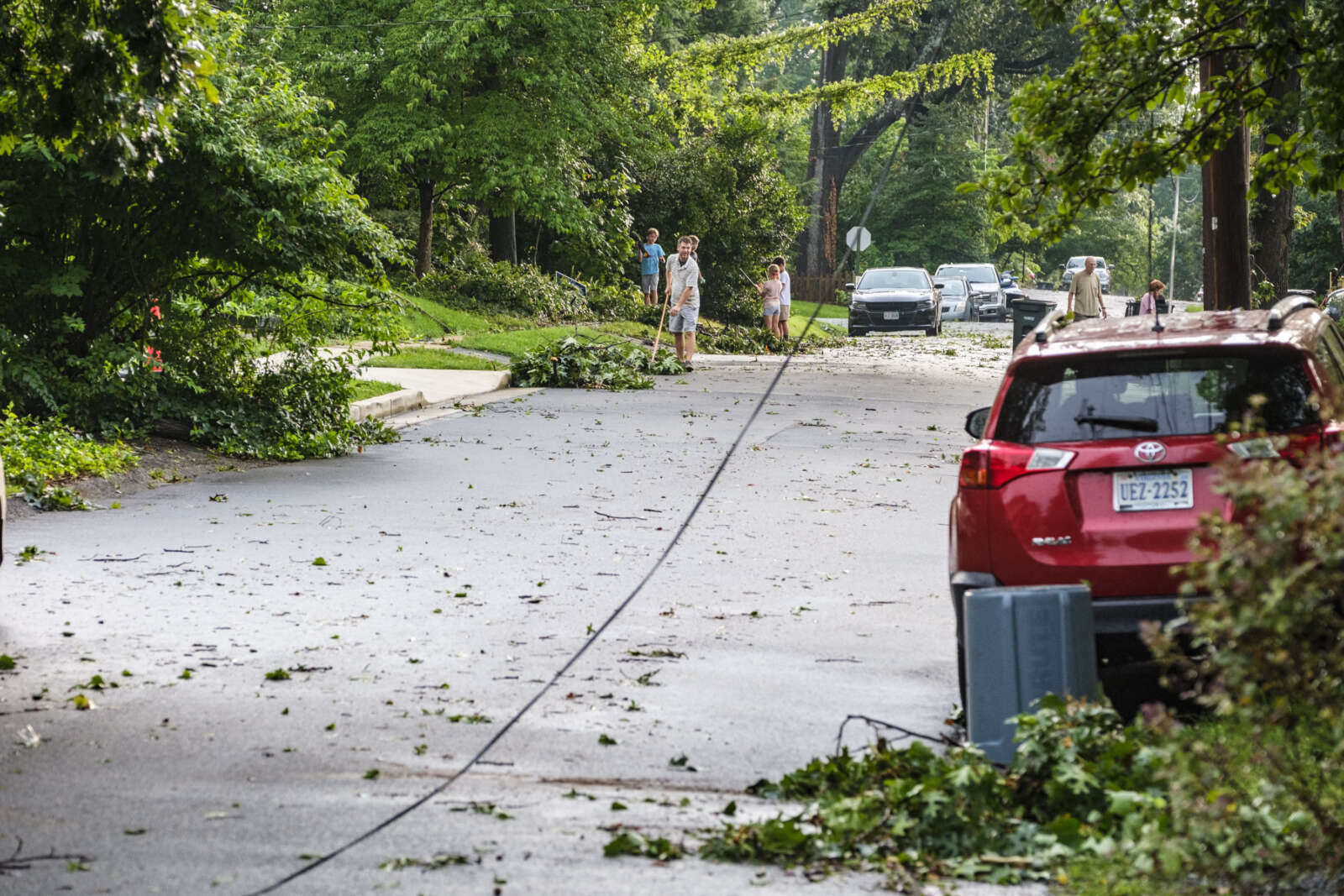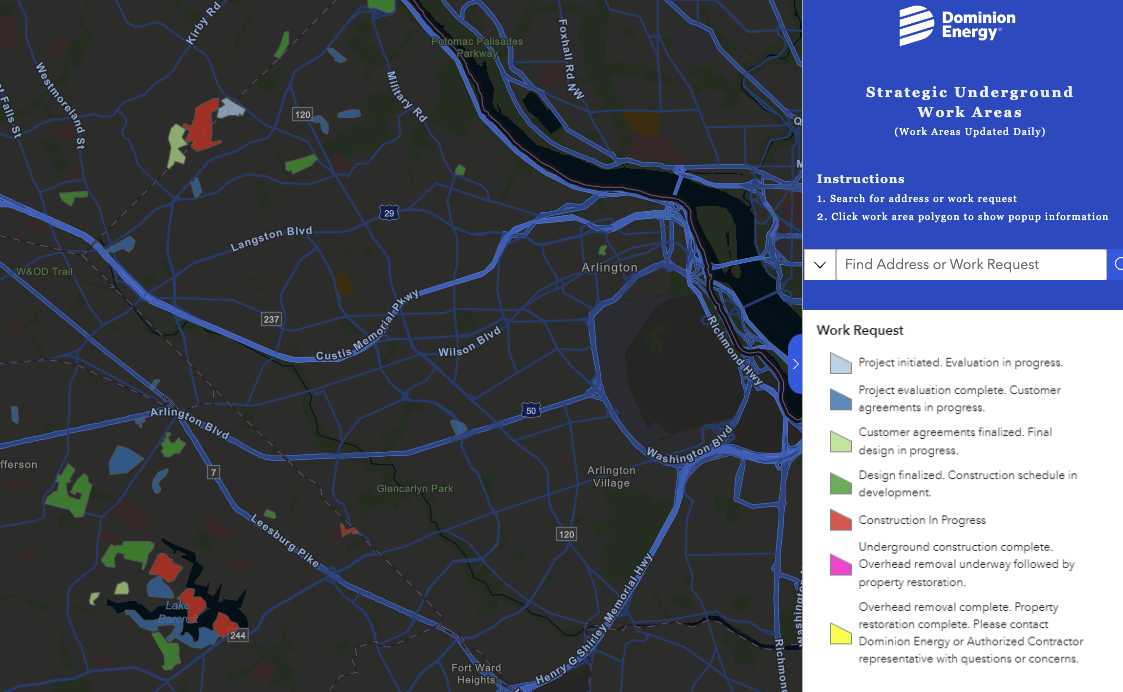
(Updated on 8/18/23) After a late July tempest plunged roughly 35,000 Arlington residents into darkness, ARLnow posed a pressing question to Virginia’s largest electric utility: Why not move all power lines underground?
The short answer is red tape and price.
Local elected officials have been interested in burying power lines since the 1980s, as doing so can reduce power outages and restoration times after storm-induced outages. The trade-offs, however, include cost, customer buy-in and longer repair times.
Historically, cost has been the biggest deterrent. Virginia, Dominion and Arlington County have balked at spearheading efforts at their respective levels, citing costs. This has left the utility company and Arlington County to piece together a patchwork approach prioritizing vulnerable lines, willing property owners and deep-pocketed developers.
Whenever a storm blows through, however, causing power disruptions and requiring maintenance work, the question of a broader effort resurfaces.
Feels like we should maybe consider the possibility of planning how to under ground all of these lines 👀😳 pic.twitter.com/n8FS38DHO4
— Maureen Coffey (she/her) (@maureencoffeyva) July 30, 2023
In an interview, Dominion spokeswoman Peggy Fox underscored two obstacles.
First, the utility company needs permission from property owners, also known as an easement, to access their land. People do not always grant that permission because, Fox said, “not everybody wants the construction that goes along with it.”
“We can’t just come in and do what we want. These are people’s properties, and we want to work with them,” she said in a phone interview.
Second, burying power lines would cost billions of dollars.
After Hurricane Isabel devastated Virginia’s electrical grid in 2003, the Virginia General Assembly tasked the State Corporation Commission — which regulates utilities in Virginia — with studying the feasibility of relocating the state’s overhead distribution power lines underground.
The study says the project aimed to decrease weather-related utility interruptions, reduce maintenance costs and lessen “visual pollution.”
Elected officials scrapped the project after learning it could cost around $83 billion, to be borne by utility customers via higher taxes or rates, and could cause “significant disruptions.”
“The potential benefits, both to the utilities and to the economy, resulting from the elimination of tree trimming maintenance, vehicle accidents, post-storm restoration, and lost sales during outages, do not appear to be sufficient to offset the initial construction costs associated with a comprehensive program to relocate the currently existing overhead utility distribution lines to underground,” the report stated.
Fox said she cannot “pinpoint” how much it would cost to underground all overhead power lines in Arlington, let alone the state. Adjusted for inflation, $83 billion would be roughly $130 billion today.
Arlington County has also shied away from taking on this work over costs. In 2015, then-Arlington County Board Chair Mary Hynes said a local effort to bury electrical and telecommunication wires would cost billions of dollars the county did not have, the Sun Gazette reported at the time.
Nevertheless, Dominion and the county have taken steps to move underground several miles of power lines in Arlington.
In 2014, Dominion embarked on its Strategic Underground Plan (SUP) to bury 4,000 miles of vulnerable overhead lines throughout the state. So far, it has buried around 1,907 miles — nearly the halfway point.
“We know that 60% of… neighborhood line outages occur on 20% of the mileage, so it makes sense to focus on the more problematic areas with a targeted approach that improves reliability for all customers,” Fox said.
Dominion has completed seven projects and has 13 in progress in Arlington. Citing customer privacy, Fox said Dominion is “not at liberty to discuss the specific locations of those past and present projects.”
Its website, however, maps projects being designed or where work has started. The map shows that most projects are concentrated in North Arlington, along Yorktown Blvd and near the GW Parkway, which sustained significant tree damage during July’s storm.

Fox said Dominion customers bear the cost of burying the lines, which amounts to an additional $1.99 per month, on average. The state periodically evaluates this rate.
Although there is no official end date, through this project Dominion aims to reduce the number of repair locations by up to 50%, Fox said.
“The SUP is most definitely fulfilling its objectives,” she said, underscoring relatively quick turnaround times from recent storms, such as Winter Storm Frida in January 2022 which caused about 200,000 customer outages in Northern Virginia.
“With about slightly less than half of SUP complete at the time, restoration took 4.5 days,” she said. “If there were no SUP, it would’ve been 5 days. If all 4,000 miles of SUP were complete, restoration time drops to 3.5 days.”
While restoration times may drop because workers have to visit fewer outage sites, repairing underground lines is trickier.
“We have to go and dig things up,” Fox said. “That’s going to take longer.”
Even with buried electric lines, wooden poles remain in place.
Where possible, Fox said Dominion is reinforcing overhead lines with “stronger, bigger, higher poles” as well as with fiberglass cross arms, which are more durable than existing wooden ones.
“The new cross arms last longer and are designed to absorb impacts by coming off of a pole separately without bringing down the pole,” she said. “Replacing a single broken pole can take at least eight hours. We rarely see the new poles down during restoration efforts.”
Arlington County, meanwhile, has been taking utilities underground, mile by mile, since the late 1980s. The county has two approaches: paying for it with tax dollars or enlisting help and soliciting funds from developers.
Going back to 1989, the county proposed a 15-year, $79.3 million plan to bury about 20 miles of utility wires along the Rosslyn-Ballston corridor and along Columbia Pike, Langston Blvd and Glebe Road.
So far, it has put lines underground at the intersection of Glebe Road and Langston Blvd, and along Wilson Blvd from N. Quincy Street to 10th Street N. As part of a years-long project, set to wrap up in three years, the county is undergrounding utilities along Columbia Pike.
The county also has a mechanism for guiding where developers add utility lines. Two years ago, former ARLnow opinion writer Nicole Merlene pointed to a 2002 document that outlines where no “new” utility poles can be built, which she says can be used to tell developers where to bury lines.
Like other local leaders, Merlene says the county can exercise more leadership via a comprehensive look at what projects it should undertake and which should get left to developers, rather than “putting it together piecemeal.”
“Our 15-year plan from 2002 is obviously out of date. We have not come close to realizing those objectives and, to me, the reason seems obvious — it is expensive,” Merlene wrote at the time. “If our baseline is knowing that none of our major planning corridors will be paid for by Dominion (the state) since they are ‘main lines,’ then unfortunately the onus is on Arlington to accomplish undergrounding improvements.”

